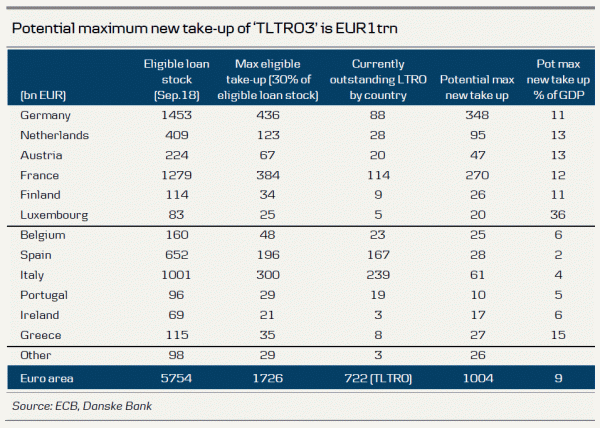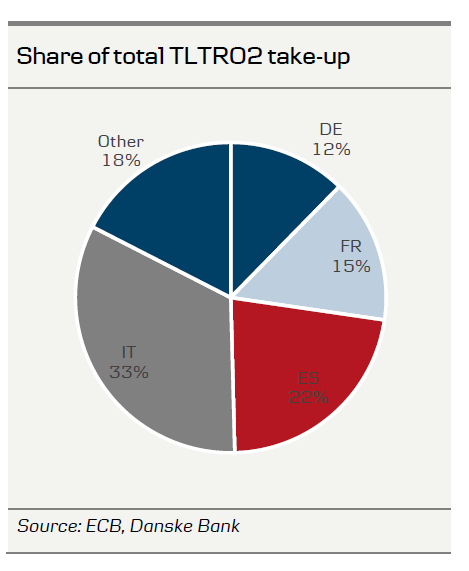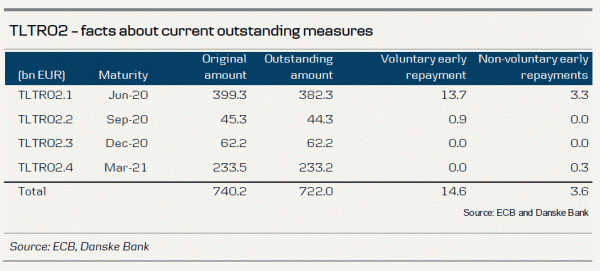Targeted longer term refinancing operations (TLTRO) – the silent measure that supports loan growth – have returned to the market’s attention recently on speculation about the potential for another round/extension of TLTRO and we concur. During the ECB’s October press conference, President Mario Draghi said that governing council members (GC) had mentioned the TLTRO without going into detail. Since then, starting just a few hours later, several GC members have mentioned the measure. Since this summer, we have argued that another TLTRO round could be in the pipeline given the new regulatory requirements implemented from July 2019 and that the fragility as well as dependency of southern European banks could be a risk for the banking sector should this terminate. We stress the ECB has not announced a TLTRO3 measure yet but that it is our expectation there will be another round. A recent Bloomberg survey of analysts suggested two-thirds expect some sort of TLTRO.
Current rules – expected to be applied again
We expect another round of TLTROs, which would have similar characteristics as the TLTRO2s, i.e. banks can take up to 30% of the banks’ eligible loan stock (loans to households excluding house purchases and loans to non-financial corporations) (for details see TLTRO2 6 EUR11bn of voluntary repayments , 22 June). We expect the new round to be announced in Q1 19 and implemented in Q2 19, before the TLTRO2.1 operation has less than 1Y to maturity. While the ECB’s GC has not yet discussed this in detail, we consider it would be a politically ‘easy’ measure to deploy, as it is supports lending growth and is collateralised (unlike the APP). Further, it would be part of the ‘dovish tightening’ style that we have seen from the ECB over the past few years. We expect a maturity of three to four years.
New additional take up at TLTRO3 – possibly EUR100-150bn
The parameters for another round of TLTRO are not clear, as the economic expansion and the health of the banking sector are significantly different from when TLTROs were first deployed in 2014. The following things, among others, are uncertain. Could the ECB choose to extend the current operations (and not offer new liquidity)? Could it use a floating rate strategy instead of its fixed MRO/deposit rate? What would be the maturity? This means that estimating the take-up of the TLTRO3 is difficult; in the following we assume the 30% limit on eligible loan stock will be applied and fixed rate, i.e. applying the MRO/ deposit rate prevailing at the time of allotment. The latter is a strong argument for larger take-up due to the carry possibility and the prospect of the ECB hiking rates in H2 19. We do not expect there to be any stigmatisation prevailing in the TLTRO3, unlike the LTROs in 2011/12.
We estimate the maximum total eligible take-up could be up to an additional EUR1trn (as of September 2018). The current eligible loan stock is EUR1,726bn, significantly higher than the EUR722bn currently outstanding (see table on page 1). However, we do not expect the take-up to be anywhere close to such a number, as additional capacity from the main takers in the TLTRO2 are very limited (Spain and Italy took more than 50% in TLTRO2). The Spanish and Italian bank sectors took around 25% of the maximum of 30% in TLTRO2.
Uncertainty about the new take-up is high at this stage but we expect around EUR100-150bn in additional funds could be taken (on top of the rollover possibility), with most take-up in the larger countries. Given the current political/market turmoil, we expect Italian banks, in particular, to be very active in the operations and come very close to the 30% limit. However, as euro area banks may use them simply as three- or four-year liquidity operations, we may see a large take-up ahead of the first rate hike, should the rules remain at MRO/deposit rate prevailing at the time of allotment.
Early repayment – small and expected to continue to be small
So far, we have only seen a small voluntary early repayment from the banks, as banks have little incentive to do so (see TLTRO2 – EUR11bn of voluntary repayments, 22 June). TLTRO2.1 and TLTR2.2, which are the only operations to have had early voluntary repayments, have seen early repayments of EUR13.7bn and EUR0.9bn, respectively
Support for the southern European banking sectors
As mentioned above, the largest take-up in TLTRO2 was taken by Italy and Spain, with close to 15% of GDP taken (24% of eligible loan stock) to support their fragile banking sectors. Since then (2014-16), the Spanish banking sector has seen a strong improvement following the bank recapitalisation in the midst of the crisis and supported by the recovery/expansion of the economy in general. However, the Italian banking sector remains fragile, with the sovereign-bank feedback loop (the so-called ‘doom loop’) still alive and kicking amid the current political challenges in Italy (see Italian Politics Monitor – The gloves are off, 23 October). Therefore, given the health and current stance of European banks, we believe the main beneficiary of another round of TLTROs would be Italy.
Impact on economic growth
It is difficult to estimate the economic growth impact of the TLTROs. While it is not a bazooka-like instrument such as the ECB’s Asset Purchase Programme (APP), it is a solid tool that supports loan growth, which plays an integral part in the ECB’s toolbox. Even though the economic impact is difficult to estimate, the TLTRO (together with APP and forward guidance) has supported the transmission mechanism of lower rates to the private sector. Lending rates to households and non-financial corporations have declined by almost 2pp since the first TLTRO was launched in summer 2014. This leads us to conclude that the existing TLTROs (together with the above-mentioned measures) have had a significant positive lasting impact on lending growth, as well as pushing lending rates lower, while any additional TLTRO impact on lending rates may have a diminishing, but still nonnegative, impact on the euro area as a whole




















